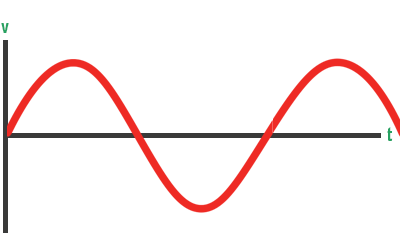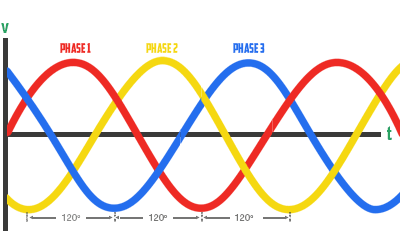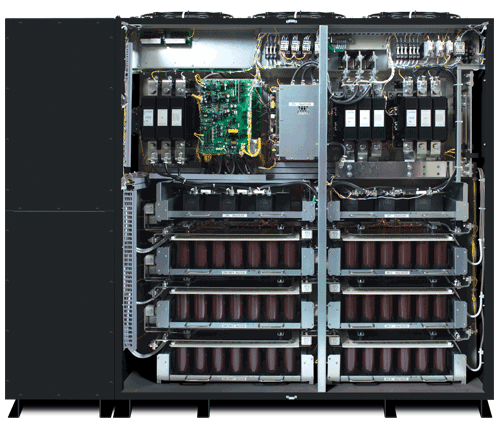BLOG
BLOG
What is a UPS?
DECEMBER 7, 2023
A UPS (Uninterruptible Power Supply) is a backup power system that provides protection to the connected loads in case of utility power loss.
Sustaining a continuous power supply is achieved by providing power from an alternate source – such as batteries – for a pre-determined time until either the utility power returns, or the facility can switch to another source such as a generator or fuel cell.
For the crucial period between when the power is lost and the alternate generator starts, the uninterruptible power supply starts within fractions of a second to fill the gap in load, assisting in a smooth and safe transition between the two power sources.
Ensuring this transition takes place in a seamless and timely manner is the UPS system’s main purpose, which is why UPS reliability is such a crucial factor in the equipment decision-making process.
An uninterruptible power supply not only acts as a backup power supply in the case of a utility outage, but also as a power conditioner. The UPS backup system will provide clean and uninterrupted power to your critical loads, even when loads from the utility are subject to spikes, surges, or other frequency and voltage problems that can damage your equipment.
How do I know if I need an Uninterruptible Power Supply?
We know the answer to the first question, “What is a UPS?” Now, let’s discuss the factors that play a role in your decision to get a backup power supply.
Ask yourself: What is the cost of downtime for my business? How expensive – how critical – are my power needs?
Understanding what it costs if your operations were to lose power is vital to your efficiency and critical in determining the value of a UPS to your business.
The cost of downtime will determine how critical your power needs are, and which backup power supply capabilities will matter most to your business’s application.
For the critical applications mentioned above, where seconds of downtime per year translate to millions lost or even lives threatened, a power availability rating of 99.9999%* is the preferred benchmark. The most reliable and well-maintained uninterruptible power supply systems can provide this level of reliability and power availability.
For businesses where the cost of an outage is minimal and there is little concern regarding the safety of the larger electrical system, simply using a generator or battery backup may be acceptable and deploying an uninterruptible power supply may not be necessary.
What are the different types of Uninterruptible Power Supply Systems?
We’ve answered the question, “What is a UPS?” and why you may need one, so let’s briefly touch on the different voltage configurations and systems.
Voltage Configurations
The two types of voltage configurations are single phase and three phase, with the main difference being as simple as how many power wires are connected to the UPS backup system.

In single phase, power flows through two wires – a power wire (phase) from the source to the load and the returning via a neutral wire to the source.
Many single phase UPS backup systems are used for backing up individual computers, individual IT racks, or other applications with limited load (less than 10kVA).

In a 3 phase UPS, there are three power wires (phases) that each carry an alternating current of the same frequency and voltage. A three phase UPS may also have a fourth neutral wire, which is called a three phase, four wire UPS.
Three phase UPS products typically go from 10kVA (approx.) to 2000kW.
Types of Uninterruptible Power Supply Systems
The three most common types of uninterruptible power supply systems are: Standby (offline), Line-Interactive, and Online Double Conversion.
It is common to see single phase voltage configurations in all three types of system design. However, three phase UPS products are commonly online double conversion. All of Mitsubishi Electric’s Uninterruptible Power Supplies are online double conversion to reliably deliver clean, protected power.
Learn more about the differences between the types of static UPS backup power systems.

Next Steps in Your Critical Power Journey
Selecting an uninterruptible power supply is crucial to protecting your critical infrastructure and ensuring a continuous power supply for your business’s operations. It is a major decision and investment and requires a business to consider many aspects.
Below are a variety of recommended resources that may help on your journey to maximum uptime. And, of course, contact us with any questions or upcoming projects.
- Power Conditioning: More than Just Backup Power
- Minimize UPS Downtime in Critical Power System Design
- What Size UPS Do I Need? The Basics of Sizing a UPS
*In the critical power industry, an availability rating of 99.9999%, referred to as the “six nines,” means that each year there are only 31.56 seconds of downtime.
Edited by Nicole Kristof, Senior Marketing Specialist
Stay up-to-date on industry trends & insights
Be the first notified of new blog posts
By submitting this contact form, you agree that a representative(s) of Mitsubishi Electric Power Products, Inc. (MEPPI) may contact you using the information you provided. In accordance with our Privacy Policy, we will never share or sell your personal data.



